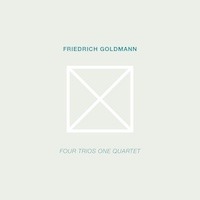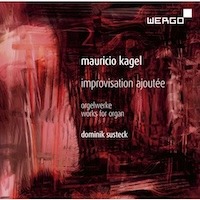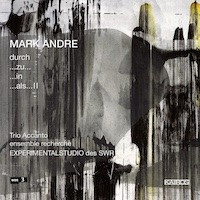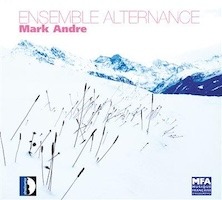A Fortifying Ramble, with Oil Drum and Toaster
|
Grant Chu Covell [June 2025.]
“Late Works.” Friedrich GOLDMANN: Haiku à 6 (1994)1; Ensemblekonzert 3 (2007)2; Sisyphos zu zweit (2008)3; Wege Gewirr Ausblick (2007/08)4. Modern Art Sextet1, Musikfabrik2, Enno Poppe2 (cond.), DuoKaya3: Biliana Voutchkova (vln), Agnieszka Dziubak (vlc), Orchestra of the Dresden Conservatory4, Ekkehard Klemm4 (cond.). Macro M24 (1 CD) (www.macro-rec.com). “Four Trios One Quartet.” Friedrich GOLDMANN: Trio (Four Pieces) for Viola, Violincello and Doublebass (1986)1; Trio No. 2 for Oboe, Violoncello and Piano (1998)2; Quartet for Oboe, Violin, Viola and Violoncello (2000)3; Trio for Violin, Horn and Piano (2004)4; Calmo, esitando un po’ (2004)5. Simon Strasser2, Ingo Goritzki3 (ob), Christian Vogel5 (clar), Noam Yogev4 (hrn), Benjamin Hudson3 (vln), Kirstin Maria Pientka1, Jean-Eric Soucy3, Chatschatur Kanajan4 (vla), Ringela Rienke1, Dirk Beiße2,5, Francis Gouton3 (vlc), Arnulf Ballhorn1 (cbs), Christine Paté5 (accord), Ernst Surberg2, Björn Lehmann4(pno). Macro M46 (1 CD) (www.macro-rec.com). Goldmann (1941-2009) lived long enough to ride or eschew multiple trends. He studied with Stockhausen and ended up in East Germany. He’s one of the three conductors on the 1996 Gruppen recording (DG 447 761-2). Perhaps he tired of mid-century dogma and experimentation for experimentation’s sake. His pieces reveal an assured designer, someone comfortable with tonal bits, repetitions, microtones and unisons, sometimes gently straying or recalling other music or genres. Goldmann is generally untroubled, without arrogance or the need to preach. Why have we not heard more of his music? Haiku à 6 unspools a delicately painted essay for flute, clarinet, piano and string trio. Sisyphos zu zweit sequences several moody experiments for violin and cello. These works are through composed, starting in one place and arriving elsewhere, presenting ideas, exploring them before veering into unexpected but completely reasonable directions. Ensemblekonzert 3 and Wege Gewirr Ausblick are orchestral. Ensemblekonzert 3 collects 16 soloists (with electric guitar and percussion) whereas Wege Gewirr Ausblick dispatches tall blocks and intricate choirs. Ensemblekonzert 3 is the standout, perpetually cresting and dipping, stitching together candid moments under a changing spotlight. The chamber concerto is a fantasia on a Bach bass line, but this is invisible. This chamber concerto proceeds like a train through a varied landscape but also colored through different passengers’ perspectives. Wege Gewirr Ausblick’s single movement advances purposefully. Here and there doodling oboe, burbling synthesizer or brass fanfares demonstrate Goldmann’s mastery of historic gestures. Around the nine-minute mark there’s an aggressive episode for piano and percussion which equals any postwar statement by Henze, Ligeti or Zimmermann. Sometimes the motion coalesces around a single pitch, or chords change their temperature in a nod to Schoenberg’s “Farben.” Goldmann’s worklist suggests he specialized in trios. There’s a fine Piano Trio from 1978 which is as lean and direct as these works. The low-string trio (viola, cello, double bass), Four Pieces, pushes plush sounds. In Trio No. 2, the oboe, cello and piano tumble acrobatically. The quartet of oboe plus string trio rotates through equals in varied combinations. All these pieces employ extended technique undramatically; microtones and forearm clusters fit logically. The Horn Trio astonishes with one foot anchored in Brahms, the other stepping into the future. The tapping at the end is not unsurprising, nor is the gentle wailing. Calmo, esitando un po’ for an unlikely clarinet, cello and accordion also unfolds with unfailing logic as the wind timbres blend. It’s never clear whether Goldmann will conclude with a flourish or simply dissipate.
“Improvisation Ajoutée, Works for Organ.” Mauricio KAGEL: Improvisation ajoutée (1962); Rrrrrrr… (1980/81); General Bass (1972); Phantasie (1967). Dominik SUSTECK: K-A-G-E-L (2012). Dominik Susteck (org), Tobias Hagedorn, Boris Heinrich (assistants). Wergo WER 7345 2 (1 CD) (www.wergo.de). I don’t think I can adequately explain how Kagel works his magic. In his theatrical pieces, he tweaks concert music’s standard expectations. Kagel’s musicians are actors who happen to create music. His performers may be tasked with non-traditional actions like speaking or looking at the audience in a particular way, and of course, playing music which may be unexpected, humorous, or resolutely mundane. Improvisation ajoutée raises a ruckus. An organist’s assistants are usually inobtrusive, but here they shout and laugh, and are anything but invisible. The music itself is precisely scored. It may sound chaotic, but this is due to the music’s density and the assistants’ continual activity. The work asks performers and listeners to reconsider (or confirm) how organ music is played and heard. The king of instruments, the sacred standby, was late to post-war developments in contemporary music. At its 1962 premiere, Improvisation upset those who expected organ music to be sacrosanct and not profane. Imagine a soundtrack for the activity at the edges of a Bosch panel. Rrrrrrr… are eight amusements and parodies from a larger collection whose titles all begin with the letter “r.” With titles like “Raga,” “Ragtime-Waltz,” and “Ripieno,” these are ostensibly straightforward miniatures, though Kagel plays with our expectations, e.g.: “Raga” proffers Oriental gibberish. “Rossignols enrhumés” introduces us to a sick bird, rasping in the lowest register possible. The Phantasie requires a tape reflecting the organist’s daily life up until the moment the work is played (ablutions, making breakfast, commuting, a church service, etc.). General Bass is a sedate, low-toned meditation at odds with its title. Susteck’s five improvisations complement Kagel. As Kagel critiqued tradition from within, so continues Susteck who explores his instrument’s astonishing versatility (the Organ Kunst-Station Sankt Peter, Cologne) enhancing sounds encountered in the Kagel with an insider’s flair.
Mark ANDRE: Durch (2004-05)1; …zu… (2004)2; …in (2002)3; …als… II (2001)4. Trio Accanto1: Marcus Weiss (sax), Christian Dierstein (perc), Yukiko Sugawara (pno), ensemble recherche: Shizuyo Oka3,4 (b-clar), Klaus Steffes-Holländer4 (pno), Melise Mellinger2 (vln), Barbara Maurer2 (vla), Åsa Åkerberg2,4 (vlc), EXPERIMENTALSTUDIO des SWR4. Kairos 0012732KAI (1 CD) (www.kairos-music.com). Mark ANDRE: iv 4 (2008-09)1; Contrapunctus (1998-99)2; “…zum staub sollst du zurückkehren…” (2004-05)3; iv 3 (2008)4; iv 2 (2007)5. Ensemble Alternance: Jean-Luc Menet1,3 (fl), Jean-Pierre Arnaud1 (ob), Dirk Descheemaeker1,3,4 (clar), Florian Coutet1 (tuba), Daniel Ciampolini3 (perc), Jean-Marie Cottet2,3 (pno), Jacques Ghestem3 (vln), Pierre-Henri Xuereb3 (vla), Frédéric Baldassare3,5 (vlc). Stradivarius STR 33837 (1 CD) (www.stradivarius.it). In an age where the freshest new music slouches towards tidy tonality, a brief visit with Andre (there was once an acute accent over the “e”) reasserts the viability of subtle dissonant music. Perhaps while visiting a big city, we may glance upwards to see a carved cornice or fancy brickwork and wonder “Who had the time to do that?” before continuing along, filling our day with meaningless trivia and interacting with our silly devices. I imagine Andre as one of the last workmen of our age. Perhaps he had a hand in Notre Dame’s restoration. For those that don’t know Andre, the quick blurb is that this Grisey and Lachenmann student (both!) has written finely detailed works that warrant close listening. There can be long notes, gaps, then knots of activity and unusual instrumental sounds. Durch’s sax, piano and percussion trio nudges dust particles into slow motion. The string trio in …zu… vanishes behind slides and snaps, producing less content than the single bass clarinet found within …in. Electronics add extra noises to the clarinet, piano and cello of …als… II which can sound like rummaging in a dark suitcase. Depending upon one’s mood, Andre can slip into self-parody: iv 4 (flute, oboe, clarinet, tuba) may focus a bit much on the tuba’s slapped mouthpiece at its start. “…zum staub” (flute, clarinet, string trio, piano and percussion) scatters wisps and creaks. The solos iv 3 (clarinet) and iv 2 (cello) lightly spread non-traditional sounds. The cryptic titles are not helpful; however, we can at least differentiate one item from another. But actually, Andre’s designations have precise Biblical references: …als… and …zu… connect to the Book of Revelation, Durch points to a passage from the Gospel According to St Luke, etc. Despite their influence, these allusions are not readily apparent. In the piano work, Contrapunctus, which is precisely notated and may sound the most normal across these two releases, the pianist must play irregular note groups in complex rhythms (11 thirty-second notes in the time of a quarter note against 9 sixty-fourth notes in the space of an eighth note, etc.). As the piece depletes towards its close, a subdivision into sevens becomes the new meter and the time signature eventually appears as the unfathomable 3/29.296875. The cumulative effect is of a controlled experiment turning out exactly as intended.
“Broken Line.” Alvin LUCIER: Carbon Copies (1989); Risonanza (1982); Music for Pure Waves, Bass Drums and Acoustic Pendulums (1980); Broken Line (2006). Trio Nexus: Erik Drescher (glissando fl, instruments), Sebastian Berweck (pno, instruments), Martin Lorenz (perc, instruments). mode records 281 (1 CD) (www.moderecords.com). “Two Circles.” Alvin LUCIER: Three Translations of the Works of Maurizio Mochetti (2008)1; Two Circles (2012)2; I am Sitting in a Room (1968)3; Fideliotrio (1986)4. Alvin Lucier3 (voice), Simone Conforti3 (electronics), Alter Ego: Manuel Zurria1,2 (fl, a-fl), Paolo Ravaglia1,2 (clar), Aldo Campagnari1,2,4 (vln), Francesco Dillon1,2,4 (vlc), Oscar Pizzo1,2.4 (pno). mode records 295 (1 CD) (www.moderecords.com). Consider the standard behavior: musicians play, audiences listen. With Lucier, there’s much listening for the musicians, very often preparatory labors involving selecting sounds or objects that can make sound. Sometimes the music evolves at a slow scale, very often there are repetitions. Most likely there will be electronics, as Lucier’s instrument was essentially the physical sound wave. Carbon Copies asks players to create an environmental recording, mimic it, play without it, then explore the sounds that they were making. If done well – and Trio Nexus does very well – the original tape blends into the mimicry until the sounds are freed in the concluding moments. Risonanza asks the group to find objects that resonate. An oil drum and a cymbal are bombarded with sine waves that result in sympathetic vibrations. The thick metallic chords suggest alarms or runaway mechanical items, whining at incessant pitches. Music for Pure Waves, Bass Drums and Acoustic Pendulums is aptly titled. While Risonanza utilized narrowly pitched sines, in Music for, live players control sine waves which cause ping pong balls to vibrate against bass drums. Given all the effort, the result sounds like rain. The works without electronics yield slowly. Some players drift from pitch to pitch while others remain fixed in place. In Three Translations of the Works of Maurizio Mochetti, the piano tosses notes like pebbles into a pond, as flute, clarinet, violin and cello glide gradually. We’re meant to focus upon changing timbres and microtonal shifts. Likewise in Fideliotrio, viola and cello drift around steadfast piano. The idea behind Two Circles is that an electronic sound can move continuously whereas a keyboard attack fades, players must stop to breathe or pause briefly when changing bow direction. Held tones are matched against moving tones to create vibrations and overtones. Instruments and sines blur into a distorted accordion. Broken Line asks a live flute to play glissandos on a specially designed instrument alongside steady piano and vibraphone. The varied attacks and decays create blurry microtonal chords as piano fuses into sliding flute and wriggling vibes. Lucier died in 2021. In 2012, at the age of 81, he (re)recorded his self-describing and self-destructive classic I am Sitting in a Room, a miracle of feedback and resonance:
Continually played back and recorded, the room’s frequencies contribute feedback which slowly eats into Lucier’s monologue. Electronic humming and whistling increasingly overwhelm. It could be something captured at the bottom of the ocean, or during an arctic storm. Compared to previous versions, Lucier appears shaky, which lends a bittersweet air. He is no longer here, but left us much.
[More Grant Chu Covell, Rambles]
[Previous Article:
Used Bin Troll Tweets VVV.]
[Next Article:
Double 70s]
|






